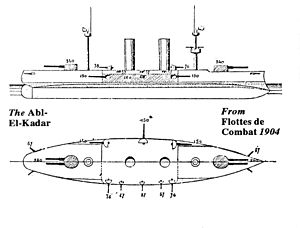- Ottoman battleship Abdul Kadir
-

Plan and side views of the rearmed shipClass overview Name: Abdul Kadir Operators:  Ottoman Navy
Ottoman NavyBuilt: October 1892–1911 Planned: 1 Cancelled: 1 Career 
Name: Abdul Kadir Operator: Ottoman Navy Ordered: 1890[1] Builder: Constantinople Laid down: 1892[1] Fate: Scrapped 1914 General characteristics (as designed) Type: Pre-dreadnought battleship Displacement: 8,100 long tons (8,230 t)[1] Length: 340 ft (103.6 m)[1] Beam: 65 ft (19.8 m)[1] Draft: 23 ft 6 in (7.16 m)[1] Propulsion: 2 shafts, 12,000 ihp (8,948 kW) (estimated)[1] Speed: 18 knots (33 km/h; 21 mph) (estimated)[1] Armament: 2 × 2 - 283 mm (11 in) guns
6 × 1 - 150 mm (5.9 in) guns
8 × 1 - 87-millimeter (3.4 in) guns
8 × 1 - 37-millimeter (1.5 in) guns
6 × 1 - 14-inch (356 mm) torpedo tubes[1]Armor: Belt: 9 in (229 mm)
Deck: 2.5 in (64 mm)
Barbette: 6 in (152 mm)
Bulkheads: 4 in (102 mm) [1]Abdul Kadir was an Ottoman pre-dreadnought battleship laid down in 1892 at the Constantinople dockyard. After she was framed with armor near the turn of the century, very little work was done to her other than to plate in the area near the keel before work ceased. When work was scheduled to resume in full force in 1904, the keel blocks had shifted and rendered her a total loss. She was scrapped in the slipway in 1914, near the start of World War I. She was to have a main armament of four 283-millimeter (11 in) guns, mounted in barbettes protected by 6 inches (152 mm) of armor.
Contents
Design
The Abdul Kadir was the Ottoman Navy's first pre-dreadnought.[2][3] She was to have displaced 8,100 long tons (8,230 t), been 340 ft (103.6 m) long, have a beam of 65 ft (19.8 m) and a draft of 23 ft 6 in (7.2 m).[2][3] Along with the elderly central battery ironclad Mesudiye, she would have been one of the largest ships in the Ottoman Navy.[4]
Characteristics
The Abdul Kadir was to have displaced 8,100 long tons (8,230 t), been 340 ft (103.6 m) long, have a beam of 65 ft (19.8 m) and a draft of 23 ft 6 in (7.2 m).[2][3] She was to have been propelled by reciprocating steam engines rated at an estimated 12,000 indicated horsepower (8,900 kW) for which an unknown number of boilers provided steam. The engines drove two propeller shafts to an estimated speed of 18 knots (33 km/h; 21 mph).[2] As the Abdul Kadir was a barbette ship, her primary armament of four 283-millimeter guns were planned to be in two twin barbettes on the centerline. This was augmented by a secondary battery of six 150-millimeter (5.9 in) guns in single mounts on the sides of the ship. The ship's tertiary armament was eight 87-millimeter (3.4 in) and eight 37-millimeter (1.5 in) guns in single mounts.[2][3] Abdul Kadir was also equipped with six above-water trainable 14-inch (356 mm) torpedo tubes.[2] As a barbette ship, the Abdul Kadir had 6 inches (152 mm) of armor on the barbettes and 9 inches (229 mm) for her belt armor. The waterline belt would have been 6 feet 6 inches (2.0 m) high, although how much would have been above or below the waterline is unknown. Her deck was 2.5 inches (64 mm) thick and the bulkheads inside the ship were 4 inches (102 mm) thick.[2] Her namesake was Abdülhamid II.[1]
Construction
The Abdul Kadir was laid down in 1892 at the Constantinople Dockyard.[3] When the ship was close to launching, progress on her was slowed down at around the turn of the century, with only the belt armour being added to the ship in the next four years. After work returned to the ship in full force in 1904, it was discovered that the keel blocks (blocks designed to keep the hull of a ship stable and at an even level, which was to prevent hogging and sagging) had sunk into the ground, which twisted the ship's frame and rendered the ship a total loss.[2] Although work continued on her until 1911, she was scrapped on the slipway in 1914, near the outbreak of World War I.[2][3]
See also
- List of battleships of the Ottoman Empire
- List of naval steamships of the Ottoman Empire
References
- ^ a b c d e f g h i Conways, p. 391
- ^ a b c d e f "Ship Class: TUR Abdul Kadir". Naval History, Flixco Pty Limited.. http://navalhistory.flixco.info/H/297241x66654/8330/a0.htm. Retrieved 24 May 2010.
- ^ Keltie, Scott (1902). The Statesman's Yearbook. 39. London: The Macmillian Company. http://books.google.com/books?id=8_G23X69hdMC&pg=PA1146&lpg=PA1146&dq=ottoman+battleship+abul+kadir&source=bl&ots=Yw9P8CQCBe&sig=6_OUupAm1pMqVff8K1NAnv4i6bc&hl=en&ei=fZb6S-SMB5DOMozOnIQI&sa=X&oi=book_result&ct=result&resnum=8&ved=0CDMQ6AEwBw#v=onepage&q=abdul%20kader&f=false. Retrieved 24 May 2010.
Sources
Categories:- 1892 ships
- Abandoned military projects
- Battleships of the Ottoman Navy
- Ships built in the Ottoman Empire
Wikimedia Foundation. 2010.
